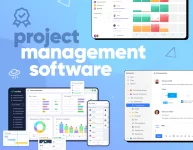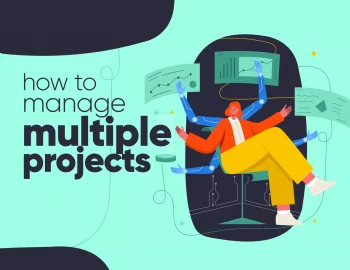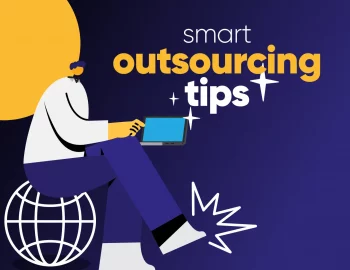Running a design agency without the right design collaboration tools is like trying to build a website in Notepad. Technically possible, but painful. You’re juggling client feedback, project deadlines, and a team that speaks three different workflow languages – designers in Figma, developers in Jira, marketers in Asana. And somewhere in the mix? A chaotic storm of Slack pings, email threads, and “Where’s the latest version?” messages.
Sound familiar? Yeah, I guess so. That’s why today I’ll help you cut through the noise and find the best design agency collaboration tools to keep your projects flowing smoothly. Simplifying client approvals, keeping your team on the same page, or just saving you from drowning in tabs, let’s dive into the tools that will actually make your life easier.
So, what are the best collaboration tools for your design agency?
Tools for Design Project Management & Tasks Organization
1. Kitchen.co
Kitchen.co is like the Swiss Army knife of project management for design agencies – it is a tool built for creative teams that need a simple, no-nonsense way to keep projects on track and enhance collaboration. It combines task management, file sharing, and client communication into one place, so you’re not constantly switching between apps. Think of it as a tidy, all-in-one workspace that makes collaboration way less chaotic.
Strengths:
- Client communication hub with an intuitive interface
- Built-in task management to track design projects
- Approval & feedback system
- File sharing & version control
- Combines many functions leading to minimal tool
switching
Weaknesses:
- No native time tracking
- Less customization options
Ideal Use Cases:
- Small to mid-sized design agencies looking for a streamlined way to manage client communication and projects in one intuitive platform.
- Agencies that struggle with scattered client feedback and need a more structured approval process.
- Teams that want to reduce tool overload by combining project management and communication.
Pricing: Free plan; $29/month for Agency White-label Plan; One-time payment for Lifetime Plans.
Seamless integration with Figma, Slack, Google Drive, Zapier, and many more key design collaboration tools, that you can see here.
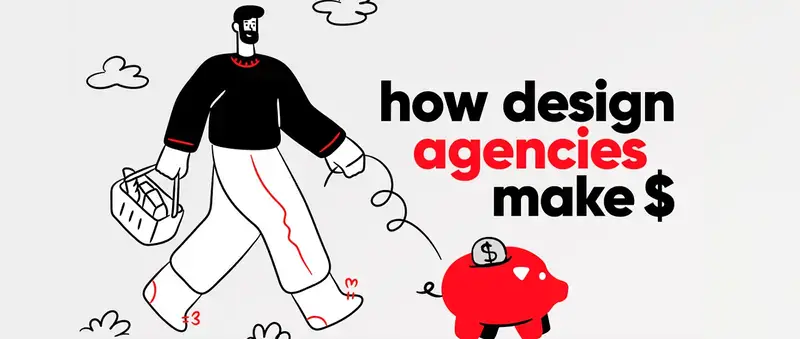
2. Asana
Asana is a tool that helps teams managing design agency workflows stay organized, track progress, and meet deadlines providing seamless task delegation, timeline visualization, and collaboration without feeling overwhelming. It’s built to handle everything from simple to-do lists to complex project roadmaps, making it an essential tool for agencies that juggle multiple projects, teams, and clients.
Strengths:
- Intuitive task & project management platform
- Automation & workflow customization
- Powerful collaboration features
- Scalability
Weaknesses:
- Can feel overwhelming at first
- No built-in proofing or client approval system
- Limited native time tracking
Ideal Use Cases:
- Design agencies managing multiple projects at once and needing a structured way to track tasks, deadlines, and progress.
- Teams looking for a scalable project management tool that grows with their workflow complexity.
- Agencies that need strong collaboration features across designers, developers, and marketers.
Pricing: Free plan; $10.99 for the Starter Plan; $24.99 for Advanced Plan; Enterprise solutions prices available upon request.
Asana offers a rich integration list connecting seamlessly with a wide range of design and development tools such as Figma, Slack, Jira, Adobe Creative Cloud and many more you can see here.
3. Basecamp
Basecamp keeps things simple. It’s not overloaded with features, but it nails the essentials: task management, team communication, and file sharing – all in one clean, easy-to-navigate package. If your agency wants a tool that feels less like a corporate project tracker and more like a streamlined workspace, Basecamp delivers.
Strengths:
- A solution that simplifies the creative process.
- Client-friendly
- Hill charts for progress tracking
- Strong file storage and management
Weaknesses:
- Limited key features
- Basic communication tools
- No native time tracking
Ideal Use Cases:
- Small to mid-sized design agencies looking for an intuitive, all-in-one project hub.
- Teams that want to reduce tool overload by combining chat, task tracking, and file sharing.
- Agencies that work closely with clients and need an easy way to keep them in the loop.
Pricing: Free Plan; $15/user per month for the Basecamp Plus Plan; $299/month flat rate for unlimited users with Basecamp Pro Unlimited.
Basecamp integrates with Slack, Google Drive, Zapier, and popular design tools, which you can see here.
4. Wimi
Wimi is a project management and collaboration platform designed to keep teams, clients, and external stakeholders aligned. It combines task managing, file sharing, messaging, and video conferencing in one place. With a strong focus on security and access control, Wimi is ideal for agencies handling sensitive client projects.
Strengths:
- All-in-one solution
- Strong security & access control
- Built-in video conferencing
- Project timelines & Gantt Charts
- Client collaboration features
Weaknesses:
- Limited third-party integrations
- Not as intuitive as some alternatives
- No free plan
Ideal Use Cases:
- Agencies managing sensitive client projects that require strict access control.
- Teams looking for a centralized collaboration hub with built-in video conferencing.
- Design teams that prefer structured tasks with Gantt charts and timelines.
Pricing: 14-day free trial; Various paid plans start at $3/user per month and go up to $15/user per month.
Wimi integrates with Google Drive, Dropbox, Google Apps for work, Evernote, and Outlook.
5. Trello
Trello is a highly visual project management tool that makes organizing tasks feel effortless. Its Kanban-style boards, lists, and cards offer an intuitive way for design agencies to track projects, from brainstorming ideas to final approvals. Thanks to its simplicity and flexibility, Trello works well for teams that prefer a more visual approach to tasks and creative collaboration in general.
Strengths:
- User-friendly Kanban Boards
- Highly customizable with Power-Ups and automations
- Collaboration-friendly
- Good for agile workflows
Weaknesses:
- Lacks native time tracking & reporting
- Can get messy with large projects
- No native proofing or client approval system
Ideal Use Cases:
- Agencies that prefer a visual, drag-and-drop approach to managing design projects.
- Smaller teams or startups looking for a lightweight, free project management tool.
- Design teams working on iterative projects that require continuous feedback and updates.
Pricing: Free Plan; $5/user per month for Standard Plan; $10/user per month for Premium Plan; Enterprise plans available for larger teams.
Trello offers integrations with Figma, Slack, Google Drive, Adobe Creative Cloud, Zapier, and many more tools. You can see the full list here.
6. ProofHub
ProofHub is an all-in-one project planning and team collaboration tool designed to streamline workflows, especially for creative teams. It stands out with built-in proofing tools that simplify the feedback and approval process, making it ideal for design agencies that need structured client collaboration.
Strengths:
- Built-in proofing & approval tools
- Task management with Kanban & Gantt Views
- Good team communication
- Flat-rate pricing
- No learning curve
Weaknesses:
- Limited third-party integrations
- No free plan
- Basic automation features
Ideal Use Cases:
- Agencies that need an efficient proofing and approval system to streamline client feedback.
- Teams that want a straightforward management tool for creative projects without the complexity of enterprise-level platforms.
- Growing agencies that prefer flat-rate pricing over per-user subscriptions.
Pricing: 14-day free trial; $45/month flat rate for Essential Plan, $89/month flat rate for Ultimate Control Plan.
Proofhub integrates with Google Drive, Dropbox, OneDrive, Slack, and a few other tools, which you can see here.
Tools for Real-Time Design Collaboration
7. Figma
Figma has revolutionized design collaboration by bringing everything into the browser. Its cloud-based design tool allows multiple users to create wireframes and work on the same file in real time, thus putting an end to the countless file versions sent back and forth. With built-in commenting, an interactive prototyping tool, and a developer-friendly Inspect mode, Figma’s tool is a go-to solution for agencies looking for an efficient design process and seamless collaboration.
Strengths:
- Real-time design collaboration tool
- Browser-based, no installs needed
- Powerful prototyping & handoff
- Version history & autosave
- Extensive plugin ecosystem
Weaknesses:
- Internet-dependent (No offline mode)
- Can be overwhelming for beginners
- Basic file management compared to some alternatives.
Ideal Use Cases:
- Agencies that need a full design collaboration tool where multiple people can work on the same file in real time.
- Team members wanting a single platform for UI/UX design, prototyping, and developer handoff.
- Remote or hybrid teams looking for a cloud-based solution to streamline workflow and design process.
Pricing: Free Plan for individuals; starting at $12/user per month for Professional Plans; starting at $5/user per month for Organization and Enterprise Plans.
Figma integrates effortlessly with Slack, Jira, Notion, Adobe Creative Cloud, and dozens of other productivity and design tools. A full list of integrations is available here.
8. Sketch
Sketch has been a go-to web design tool for UI/UX designers for years, especially for teams working on macOS. It’s fast, clean, and built specifically for digital design – no unnecessary fluff, just reliable tools to create stunning interfaces. While it used to be more of a solo designer’s tool, it’s stepped up its visual collaboration game, now offering real-time feedback and editing features, and easy developer handoff. If your team is all about precision and a smooth Mac workflow, Sketch is still a solid choice.
Strengths:
- Super smooth and fast collaborative design software
- Great for UI/UX design
- Real-time collaboration features
- Extensive library for plugins
- Solid developer handoff
Weaknesses:
- Mac-only
- Prototyping is basic
- No free plan
Ideal Use Cases:
- UI/UX teams on Mac who need a smooth, high-performance design collaboration tool.
- Agencies that love plugins and want to customize their workflow.
- Professional designers who prioritize clean, focused interfaces without extra clutter.
Pricing: Starts at $10/month per Editor, with a free Viewer plan; $120 for a one-time macOS license, and $22/month per Editor for a Business subscription.
Sketch connects with Zeplin, Abstract, Slack, Figma (via plugins), and more. You can check out the full integration list here.
Tools for Live Virtual Whiteboard Sessions and Brainstorming
9. Mural
Mural is a digital whiteboard built for strategy and brainstorming sessions and creative collaboration. It has an infinite canvas where teams can map out ideas, organize workflows, and visually structure projects with built-in templates for everything from mind maps to design sprints. With plenty of templates and sticky notes, it’s a great tool for sparking creative discussions.
Strengths:
- Infinite canvas for freeform brainstorming
- Templates for design thinking & agile workflows
- Sticky notes, voting, & timer features
- Easy client collaboration
- Strong security & access control
Weaknesses:
- Can feel cluttered for large teams
- Limited free plan
- Not a full project management tool
Ideal Use Cases:
- Agencies running virtual brainstorming or strategy sessions.
- Creatives working remotely and needing a shared space for ideation.
- Teams using design thinking or agile workflows who want structured templates.
Pricing: Free Plan; $9.99/user per month for Team+; $17.99/user per month for Business Plan; Enterprise pricing available.
Mural connects seamlessly with Slack, Microsoft Teams, Jira, Zoom, and other popular design collaboration tools. A full list of integrations is available here.
10. Miro
Miro is one of the most versatile visual design collaboration tools on the market, perfect for brainstorming, wireframing, and team planning. It’s great for sketching out initial design concepts or refining complex workflows, as the almost infinite collaborative whiteboard platform allows team members to create user flows, mood boards, and project roadmaps with ease.
Strengths:
- Flexible whiteboarding & wireframing
- Real-time & asynchronous collaboration
- Rich toolset with sticky notes, shapes, & connectors
- Smart meetings & workshops features
Weaknesses:
- Overwhelming for new users
- Can become cluttered
- Limited offline access
Ideal Use Cases:
- Design teams mapping out UX/UI flows before moving into prototyping.
- Agencies running creative workshops with clients or stakeholders.
- Remote teams that need an interactive workspace for real-time or async collaboration.
Pricing: Free Plan; $8/user per month for Starter Plan; $16/user per month for Business Plan; Enterprise Plan available.
Miro integrates effortlessly with Figma, Adobe Creative Cloud, Slack, Notion, Jira, and a variety of other creative and productivity platforms. See the full list here.
11. MindMeister
MindMeister is a creative collaboration software that’s all about mind mapping and turning ideas into structured plans. Whether you’re outlining a new branding concept or mapping out a marketing strategy, it gives team members an easy way to organize thoughts visually. It’s particularly useful for agencies that love free-flowing idea sessions but need a way to make sense of them afterward.
Strengths:
- Clean & intuitive mind mapping
- Collaboration in real time
- Presentation mode
- Task & note attachments
- Cloud-based & mobile-friendly
Weaknesses:
- Not a full-scale whiteboarding tool
- Basic free plan
- No advanced project management features
Ideal Use Cases:
- Design teams brainstorming branding strategies or content ideas.
- Agencies mapping out campaign concepts before structuring them in a project management tool.
- Teams that prefer a structured visual format over freeform whiteboards.
Pricing: Free Plan; $6/user per month for Personal; $10/user per month for Pro Plan; $15/user per month for Business Plans.
MindMeister syncs well with Google Drive, MeisterTask, Microsoft Teams, and Zapier, making it easy to integrate into existing workflows. More details are available here.
Tools for Managing Design Assets
12. Filestage
Filestage is built for teams that deal with a constant flood of feedback. Whether you’re reviewing design files, marketing assets, or client presentations, it makes managing feedback and approvals smooth and stress-free. It’s just a centralized space where everyone can collaborate and sign off on work efficiently eliminating the messy email chains and scattered comments.
Strengths:
- Streamlined review and approval workflow
- Automatic version control
- Customizable approval steps
- Supports multiple file types
- Compliance & security features
Weaknesses:
- Pricing can add up for large teams
- No built-in design collaboration tools
(strictly a review and approval platform) - Clients might need guidance
Ideal Use Cases:
- Agencies managing feedback and client approvals for branding, web, and UX/UI projects.
- Teams looking to eliminate messy feedback chains across email and chat apps.
- Creative teams handling multimedia projects that require structured reviews.
Pricing: Free Plan; €99/month flat price for teams for Basic Plan; € 279/month flat pricing for teams for Professional Plan; Custom enterprise plans available.
Filestage integrates smoothly with Google Drive, Dropbox, Slack, Trello, and Adobe Creative Cloud, making it easy to incorporate into existing workflows. More details are available here.
13. Wrike
Wrike is where project management meets creative workflow optimization. It’s flexible enough to handle agency-wide projects while still giving designers, developers, and marketers the tools they need to keep creative work flowing. With built-in proofing, task tracking, and seamless collaboration, Wrike keeps everything moving forward without the usual bottlenecks.
Strengths:
- Built-in proofing & approval features
- Task and project management in one place
- Custom workflows for creative teams
- Enterprise-grade security
- Strong reporting & time tracking
Weaknesses:
- Interface can feel complex
- More than just asset management (best for agencies needing both project tracking and asset proofing)
- Limited free plan
Ideal Use Cases:
- Agencies that need an all-in-one solution for managing projects and asset review.
- Teams collaborating on multiple design projects with structured approval workflows.
- Creative teams looking to track time, budgets, and resources alongside design work.
Pricing: Free Plan; $10/user per month for Team Plan; $25/user per month for Business Plan; Enterprise and Pinnacles Plans available with custom pricing.
Wrike connects with Adobe Creative Cloud, Slack, Google Drive, Dropbox, and over 400 other tools. Full integration details can be found here.
Communication and Feedback
• Tools for Ongoing Communication and Team Chat
14. Slack
Slack isn’t just a chat tool – it’s the virtual hub where teams brainstorm, share updates, and keep projects on track. With channels for different projects, integrations with design and project management tools, and the ability to quickly loop in clients when needed, Slack helps agencies keep conversations flowing without getting lost in email threads.
Strengths:
- Channels keep conversations organized
- Powerful integrations
- Custom notifications & do not disturb mode
- Supports voice & video calls
- Slack connect for external collaboration
Weaknesses:
- Can be distracting
- Message limits on free plan
- No native task management
Ideal Use Cases:
- Agencies that need a central communication hub to replace scattered emails.
- Design teams working with developers who need to quickly share files and feedback.
- Creative teams collaborating remotely who want instant, real-time discussions.
Pricing: Free Plan with message limits; $7.25/user per month for Pro Plan; $12.50/user per month for Business Plan; Enterprise plan available.
Slack integrates seamlessly with Figma, Adobe Creative Cloud, Trello, Notion, Google Drive, and thousands of other tools. See the full list here.
15. Flock
Flock takes team collaboration one step further by blending messaging with productivity features like to-do lists, reminders, and polls. It’s a solid alternative to Slack, especially for agencies that want a mix of chat and lightweight task management in one place. Plus, it’s easy to onboard teams without a steep learning curve.
Strengths:
- Built-in to-do lists & reminders
- Quick polls & notes features
- More affordable than Slack
- Integrated video & voice calls
- Less cluttered interface
Weaknesses:
- Fewer third-party integrations
- Less popular among design agencies
- Interface feels more corporate
Ideal Use Cases:
- Agencies looking for a Slack alternative that includes built-in task management.
- Teams that want structured communication with fewer distractions.
- Smaller marketing and design teams that don’t need an overwhelming number of integrations.
Pricing: Free Plan; $4.50/user per month for Pro Plan; Enterprise plans available.
Flock integrates with Google Drive, Trello, Asana, Zapier, and a handful of other design collaboration tools. See the full list here.
• Tools for Video Conference
16. Zoom
Zoom is the go-to for video calls, whether it’s an internal check-in, client presentation, or remote brainstorming session. Its reliable performance and easy screen-sharing make it a must-have for agencies juggling hybrid teams and client collaborations. Bonus: It integrates seamlessly with calendar tools to keep scheduling painless.
Strengths:
- Crystal-clear video & audio
- Screen sharing with annotation
- Breakout rooms
- Recording & transcription options
- Works well across various devices
Weaknesses:
- Free Plan limits the meetings to 40 minutes
- Can be resource-heavy
- Security concerns in the past
Ideal Use Cases:
- Agencies hosting client meetings & presentations that require high-quality video.
- Teams that need a reliable, widely-used tool for internal and external calls.
- Workshops, training sessions, and collaborative brainstorming with breakout rooms.
Pricing: Free for meetings up to 40 minutes; $13.33/month per user for Pro Plan; $18.32/month per user for Business Plan.
Zoom integrates smoothly with Slack, Google Calendar, Figma, Miro, and hundreds of other productivity tools. Full list available here.
17. Whereby
Whereby is among the simplest collaborative tools out there – it’s just video conferencing without any fuss. No downloads, no complicated setups – just a simple, browser-based tool that lets teams and clients hop on calls instantly. If your agency values ease of use and quick access to meetings, then this is a strong contender.
Strengths:
- No software downloads needed
- Simple and clean interface
- Built-in screen sharing and recording
- Custom meeting links
- Strong privacy features
Weaknesses:
- Limited free plan
- Fewer advanced features than Zoom
- Best for smaller meetings
Ideal Use Cases:
- Quick, hassle-free video calls with clients, freelancers, or team members.
- Agencies that want a lightweight alternative to Zoom for smaller meetings.
- One-on-one design feedback sessions where simplicity is a key feature.
Pricing: Free for up to 4 participants (1 host); $8.99/month for Pro Plan (1 host); $11.99/month for Business plan (3 or more hosts).
Whereby integrates with Google Drive, Miro, Outlook, and YouTube.
18. GoToMeeting
GoToMeeting is a video conferencing tool with a business-first approach. It’s packed with key features like transcription, cloud recording, and advanced meeting controls, making it a solid choice for agencies that need more than just casual check-ins. So if your team hosts a lot of presentations or strategy meetings, this one’s worth considering.
Strengths:
- Highly reliable & secure
- Unlimited cloud recording
- Meeting transcriptions
- Custom backgrounds & branding
- Dial-in options for audio calls
Weaknesses:
- Less popular than Zoom (clients might not be familiar with its interface)
- More expensive than some alternatives
- Limited free version
Ideal Use Cases:
- Agencies handling high-end corporate clients who need a polished video conferencing tool.
- Teams that require transcriptions & cloud recordings for documentation.
- Secure, professional meetings where reliability is non-negotiable.
Pricing: No free plan; $12/month per user for Professional Plan (150 Participants); $16/month per user for Business Plan (250 Participants); Enterprise plans available.
GoToMeeting integrates with Slack, Outlook, Salesforce, Google Workspace, and many other business tools. Full list is available here.
Benefits of building out a design collaboration tool technology stack
A well-integrated tech stack transforms how a design agency works. Seamless tool integration boosts efficiency, keeps teams focused, and streamlines communication. The right mix of project management, design software, gathering feedback, and collaboration tools enhances creativity while reducing tool overload, project timelines, and cost.
It keeps all assets and designs in one location, enabling version control and tracking of design changes, thus reducing confusion and errors. Fewer bottlenecks, smoother feedback loops, and less chaos mean more time for innovation, which is undoubtedly at the core of a thriving agency.
What factors to consider when selecting a design collaboration tool for your agency
It doesn’t matter how popular or cool a design collaboration tool is – if it’s not suited to your agency’s needs, it won’t work well. So consider these factors when deciding:
1. Integration with current tools and design software – Does it play well with the design tools you’re already using, such as Figma, Adobe, or Sketch?
2. Ease of use and user interface – The simpler, the better – so look for tools that won’t require a steep learning curve for your team members.
3. Key features and functionality – Do the features it offers suit your workflow and design process?
4. Scalability and flexibility – As your agency grows, your tools should be able to scale with you without needing a complete overhaul.
5. Customization options – Can you adjust workflows, permissions, and processes so they fit your team’s needs?
6. Security and pricing – Make sure the tool fits your budget while still offering all the necessary features.
Ultimately, you want a suite of tools that integrates into your workflow naturally, without interrupting the entire design process. Look for solutions that not only meet your agency’s immediate needs but also help you grow over time.
Bottom line
When it comes to design agency collaboration, the key is finding tools that make your workflows smoother, your feedback loops tighter, and your communication more effective. With the right stack in place, your agency can boost team productivity, reduce stress, and, most importantly, deliver exceptional design experiences to your clients.
So, choose wisely, and don’t be afraid to test and repeat until you find the perfect balance of tools. Happy collaborating!
Looking for more helpful reads to enhance your agency’s game further? We’ve got you covered:
- Creative Agency Business Models To Consider in 2025
- All Types of Creative Agency Structure Explained
- How to Manage a Creative Team – Effective Strategies For Every Situation
- 15 Tips for Effective Communication With Clients [That Actually Work]
- 14 Best Creative Agency Employee Time Tracking Software Tools in 2025
- How to Manage Client Expectations with Confidence and Clarity


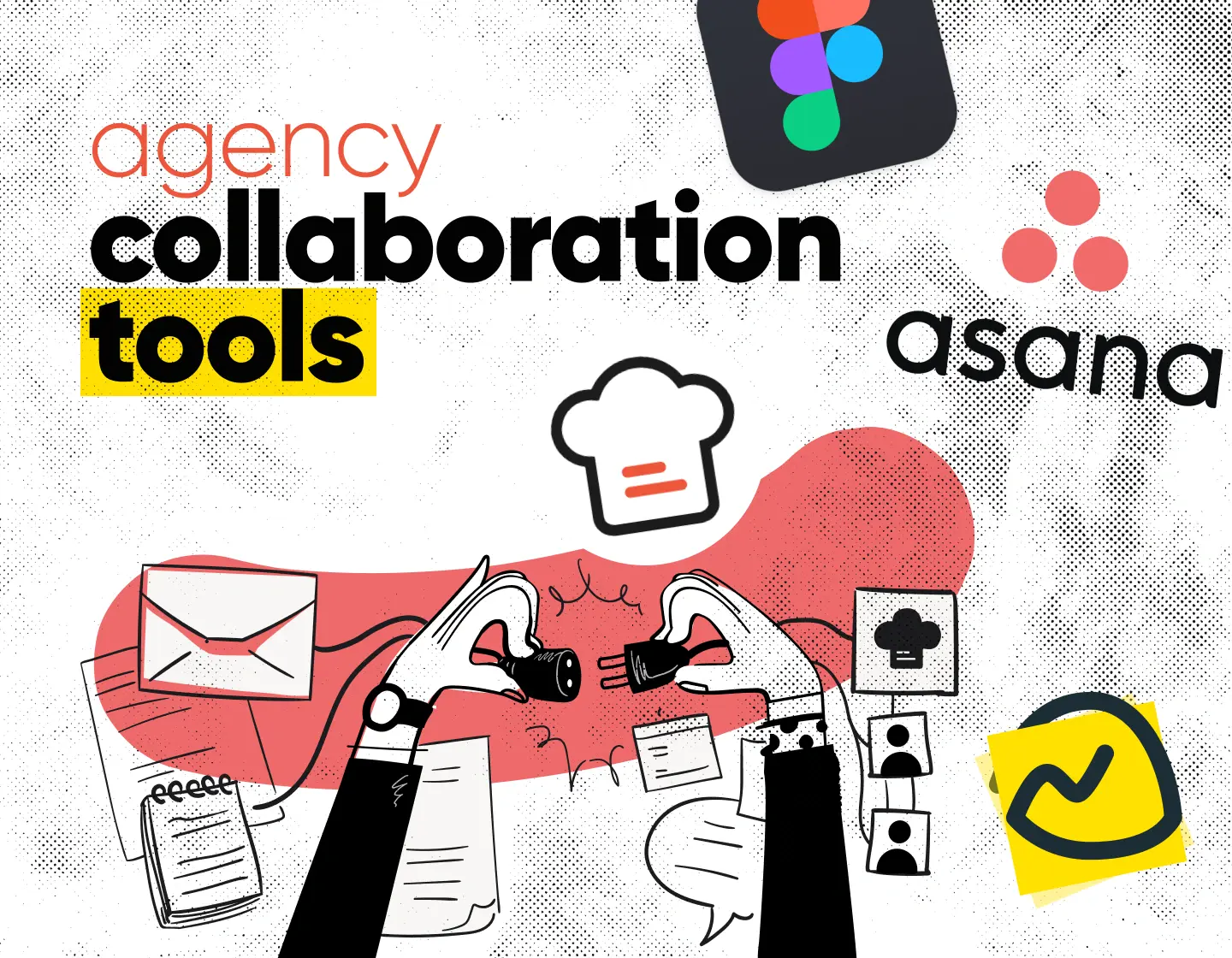

![15 Tips for Effective Communication With Clients [That Actually Work]](https://reallygooddesigns.com/wp-content/uploads/2025/04/tips_for_effective_communication_with_clients-193x150.webp)

